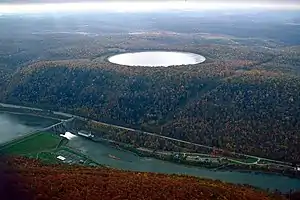| Seneca Pumped Storage Generating Station | |
|---|---|
 | |
| Country | United States |
| Location | Mead Township, Warren County, Pennsylvania |
| Coordinates | 41°50′20.58″N 79°0′13.45″W / 41.8390500°N 79.0037361°W |
| Status | Operational |
| Commission date | 1970 |
| Owner(s) | LS Power |
| Power generation | |
| Nameplate capacity | 435 MW |
Adjacent to Kinzua Dam in the Allegheny National Forest | |
The Seneca Pumped Storage Generating Station is a hydroelectric power plant using pumped storage of water to generate electric power. It is located near Warren, Pennsylvania in Warren County.
Seneca Station is colocated with the Kinzua Dam, near Warren, Pennsylvania. The dam was built by the United States Army Corps of Engineers to regulate the Allegheny River as part of a larger flood control project, and, as a secondary role, to generate hydroelectric power. It created the Allegheny Reservoir, a lake that stretches 25 miles (40 km) upriver, nearly to Salamanca, New York within the Allegany Reservation of the Seneca Nation of New York. The station generates on average approximately 570,000 megawatt hours of electric energy every year.[1] It has generated hundreds of millions of dollars in profits for its operators since opening in 1970.[2]

The power plant, rated at 451 MW, was built by the Pennsylvania Electric Company and Cleveland Electric Illuminating Company. It began commercial operation in 1970. Through business mergers and acquisitions, the plant became owned by FirstEnergy, an operator of several base load (nuclear and coal-fired) power plants. Seneca was among 11 hydroelectric power stations that FirstEnergy agreed in 2013 to sell to LS Power of New York City.[3]
Pumped storage plants function similarly to a storage battery; they absorb excess power generated by such plants in off-peak hours, such as nighttime, using it to pump water into a reservoir. Later, when demand exceeds the base load, the flow of water from the reservoir generates additional electrical power to meet peak load demands. Like all storage schemes the facility is a net consumer of electricity due to losses in the cycle.
References
- ↑ "Archived copy" (PDF). Archived from the original (PDF) on 2018-06-30. Retrieved 2018-08-21.
{{cite web}}: CS1 maint: archived copy as title (link) - ↑ Daniel Robison (WBFO), "Seneca Nation fights for control of Kinzua Dam", Innovation Trail, 18 May 2011
- ↑ "Company Briefs".